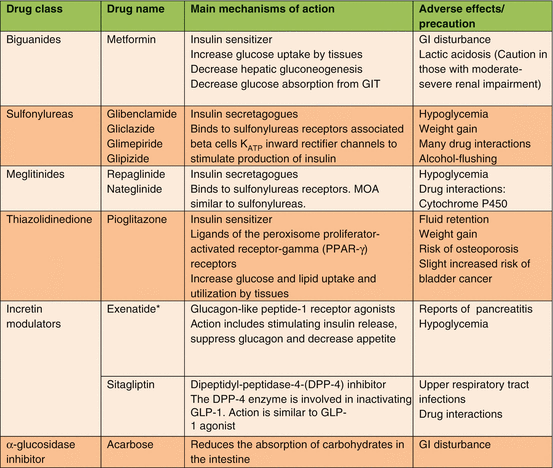Antidiabetic Agents for Type 2 Diabetes Mellitus
In patients with T2DM, the available drugs are used to stimulate insulin secretion using insulin secretagogues or to improve target organ sensitivity to insulin using insulin sensitizers. New drugs acting on incretins such as glucagon-like peptide-1 (GLP-1) have been developed. Incretins are gastrointestinal hormones that have glucose-lowering actions. GLP-1 stimulates glucose dependant insulin secretion and mediates the satiety response. Antidiabetic agents currently available are summarized in Table 16.2. Metformin is the first-line antidiabetic agent according to many guidelines due to its weight loss effects and evidence linking it to decrease in cardiovascular complications in diabetes.

Table 16.2
Antidiabetic agents for type 2 diabetes mellitus

Hyperglycemic Emergencies
In diabetic ketoacidosis, patients present with depressed mental status, dehydration, rapid deep breathing, and fluid, electrolyte and acid-base derangement. Management is based on the following four principles: (1) fluid and electrolyte therapy (2) intravenous insulin therapy (3) treatment of co-morbidities such as infections and (4) close monitoring. Electrolyte therapy includes management of potassium, in certain cases, bicarbonate and phosphate levels. IV Insulin should be adjusted regularly according to glucose levels.
Hypoglycemic Emergencies
Blood sugar level below 3.9 mmol/l (70 mg/dl) is defined as hypoglycemia. Clinical features include sweating and palpitations, and central nervous dysfunction such as blurred vision, headache and weakness which can progress to convulsions and coma. Patients with hypoglycemia can be given glucose orally or intravenously. In hypoglycemic emergencies outside hospital, when patients are unable to take orally, glucagon injections (packed in a kit) can be given, which will return blood glucose levels to normal in 10–15 min.
Adrenal Hormones
The adrenal glands produce glucocorticoids, mineralocorticoids and sex hormones. Glucocorticoids are important in the maintenance of the hypothalamic-pituitary-adrenal (HPA) axis. Glucocorticoids also play important roles in stress response and metabolic regulations. They possess potent anti-inflammatory and immunosuppressive properties. In acute inflammation, glucocorticoids decrease the activity of leucocytes while in chronic inflammation glucocorticoids reduce the clonal expansion and activity of lymphocytes. They also reduce angiogenesis and fibrosis associated with inflammation. In addition, glucocorticoids play an important role in regulating inflammatory mediators such as cytokines, prostaglandins, histamines and complement components.
The important mineralocorticoid synthesized by the adrenal glands is aldosterone. Aldosterone plays a vital role in salt and water balance in the body by regulating the renin-angiotensin-aldosterone system.
Synthetic Corticosteroids
Many synthetic corticosteroids have been developed with different potencies (Table 16.3). Corticosteroids possess potent anti-inflammatory and immunosuppressive properties and have become valuable treatment options for a wide range of clinical conditions. However, multiple adverse effects of corticosteroids have also been reported (Table 16.4). Most of the adverse effects of corticosteroids are related to the dosage given. In order to reduce adverse effects, the lowest possible dose and for the shortest duration of treatment that will produce the desired therapeutic response should be used. Steroid dose is tapered down gradually before being stopped. Sudden withdrawal of corticosteroids after prolonged or high dose may precipitate acute adrenal insufficiency. Corticosteroids may be administered by many routes: oral, intravenous, intra-articular, inhalation, eye or nasal drops and topical skin application. They are transported in the plasma bound to corticosteroid-binding globulin (CBG) and to albumin. Some synthetic glucocorticoids are not bound to protein. They are metabolized by the microsomal enzymes in the liver.
Table 16.3




Potencies of different corticosteroids
Stay updated, free articles. Join our Telegram channel

Full access? Get Clinical Tree


